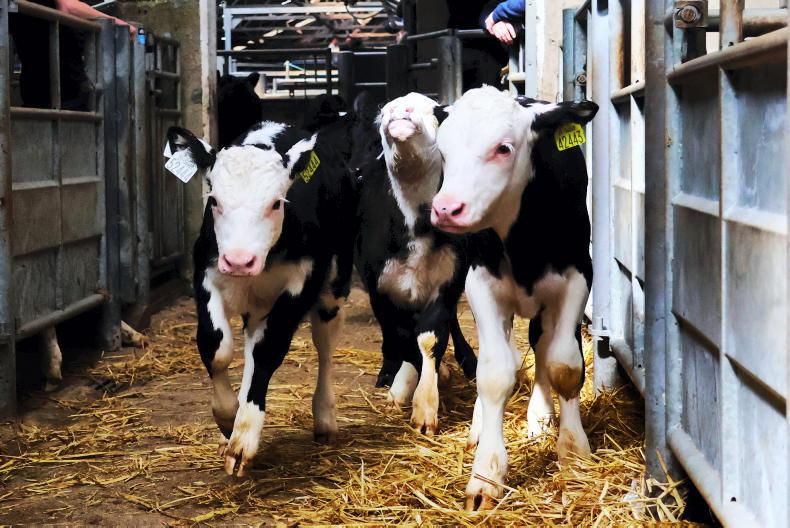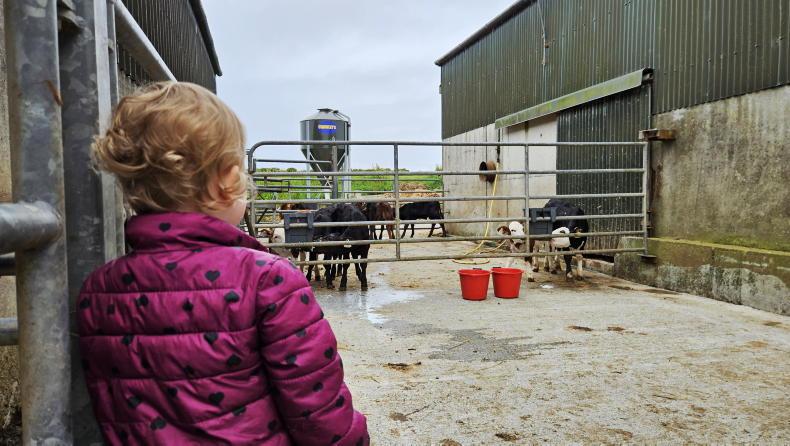BBreeding and genetics are the backbone of the industry supported THRIVE programme and there was a lot of discussion on all the stands at the open day this week in Cashel on various aspects of dairy beef production systems.
The dairy herd has been growing at the rate of about 12%/year over the last number of years while the suckler herd has been declining by about 6%/year. Beef registrations from dairy cows have been relatively stable but that is all about to change in 2023.
The latest insemination data from the 2022 breeding season points to a 28% increase in beef inseminations in dairy cows. This is coupled with a 16% decline in dairy inseminations on dairy cows.
What has changed?
Sexed semen has come more into play and has meant dairy farmers have had to breed fewer of their cows to produce replacements. The rapid expansion that was unleashed in 2015 has also ground to a halt and milk supply in 2022 is actually in decline. Dairy farmers will need fewer replacements.
Less demand for high-EBI heifer calves and breeding stock this spring would have also informed the decision-making during the breeding season.
What are the implications?
This means we will have over 100,000 more dairy beef calves on the ground in 2023. This will be the single biggest shift to dairy beef that we have seen in the last 10 years.
Most of these will be Hereford and Aberdeen Angus calves. This will present a challenge for both dairy and beef farmers as the market for these beef calves is not as simple as the Friesian bull calf moving to Holland at two weeks of age.
Another issue of concern is that calf slaughtering has increased from 17,054 calves in 2018 to 30,473 so far in 2022. It a relatively small number of farmers (200-300) currently responsible.
There was a general consensus on the day from both dairy and beef farmers that this cannot continue and if it does continue it could damage both the dairy and beef industry.
Calf exports
We exported 150,968 calves in 2018 up to July. For the same period in 2022, we are sitting at 165,638 calves, up 10% on 2018 and up 22% on the same period in 2021. The likelihood of continuing on this trajectory in the future is slim.
IBR legislation being introduced in some European countries will mean Ireland will be locked out of some of our key calf export markets without an Irish control plan in place. This is just around corner, with 2025 being the start of any likely restrictions affecting exports. The direction of EU policy also suggests calf exports at young ages will come under pressure, with age limits for export likely to be raised in the coming years. All this adds to the likelihood of a lot more calves needing to be reared on Irish beef and dairy farms in the years ahead. This isn’t a problem we need to solve when it hits us in 2026, we know what’s coming so it’s up to everybody to come up with some solutions now.
A theme on the genetics stand was the distinct lack of integration between dairy processors, beef processors, dairy farmers and beef farmers. These four groups are in the industry together yet there is very little dialogue between them. We have seen individual processors run pilot programmes but in terms of the wider industry talking to each other, it just doesn’t happen. This needs to change.
Calf quality
The dairy beef calves being born on Irish farms over the last number of years have been getting steadily worse in terms of quality. Carcase weight, carcase conformation and quality have all been in decline and the dairy farmers’ quest for easy-calving, short-gestation bulls at the expense of carcase weight and quality are coming through in our national kill profile. On a more positive note, we have managed to shave one month off the slaughter age of these animals, which shows there is potential to make some real progress on earlier slaughter and in turn lower lifetime greenhouse gas emissions of dairy-beef animals.
Key indices
Chris Daly outlined two indices which will help improve calf quality, the Dairy Beef Index (DBI) and the Commercial Beef Value (CBV). Both can help turn things around.
For me, the CBV index is a game changer for beef farmers and will lead to higher demand for high-CBV calves and lower demand for lower CBV calves. However without DNA calf registration at birth, it’s not worth the paper it’s written on.
Surely this is our chance as a country to show some leadership and innovation and become the first country in the world to have a fully traceable birth to slaughter bullet proof DNA calf registration system.
The Brexit Adjustment Reserve fund is a perfect fit for an initiative like this and with industry backing could be a real game changer for our dairy-beef issues.
We have talked about this long enough. Everybody with a stake in the industry needs to get behind this and make it happen.
The THRIVE programme is an Irish Farmers Journal dairy calf to beef demonstration programme supported by Bord Bia, ICBF, Munster Bovine, Progressive Genetics, Dovea Genetics, Kerry Group and Aurivo. Issues remain with calf quality in the dairy herd, with poorer quality animals reaching high fat covers at very low liveweights. Over 100,000 extra beef-sired calves will be born on Irish dairy farms in spring 2023.CBV index impact will be severely restricted without introduction of DNA calf registration.Calf exports have increased by 22% in 2022 compared to the same period in 2021.The cost of DNA registration is currently €22/head but will likely become cheaper in the future.Calf slaughtering has increased by 78% in the last four years.
BBreeding and genetics are the backbone of the industry supported THRIVE programme and there was a lot of discussion on all the stands at the open day this week in Cashel on various aspects of dairy beef production systems.
The dairy herd has been growing at the rate of about 12%/year over the last number of years while the suckler herd has been declining by about 6%/year. Beef registrations from dairy cows have been relatively stable but that is all about to change in 2023.
The latest insemination data from the 2022 breeding season points to a 28% increase in beef inseminations in dairy cows. This is coupled with a 16% decline in dairy inseminations on dairy cows.
What has changed?
Sexed semen has come more into play and has meant dairy farmers have had to breed fewer of their cows to produce replacements. The rapid expansion that was unleashed in 2015 has also ground to a halt and milk supply in 2022 is actually in decline. Dairy farmers will need fewer replacements.
Less demand for high-EBI heifer calves and breeding stock this spring would have also informed the decision-making during the breeding season.
What are the implications?
This means we will have over 100,000 more dairy beef calves on the ground in 2023. This will be the single biggest shift to dairy beef that we have seen in the last 10 years.
Most of these will be Hereford and Aberdeen Angus calves. This will present a challenge for both dairy and beef farmers as the market for these beef calves is not as simple as the Friesian bull calf moving to Holland at two weeks of age.
Another issue of concern is that calf slaughtering has increased from 17,054 calves in 2018 to 30,473 so far in 2022. It a relatively small number of farmers (200-300) currently responsible.
There was a general consensus on the day from both dairy and beef farmers that this cannot continue and if it does continue it could damage both the dairy and beef industry.
Calf exports
We exported 150,968 calves in 2018 up to July. For the same period in 2022, we are sitting at 165,638 calves, up 10% on 2018 and up 22% on the same period in 2021. The likelihood of continuing on this trajectory in the future is slim.
IBR legislation being introduced in some European countries will mean Ireland will be locked out of some of our key calf export markets without an Irish control plan in place. This is just around corner, with 2025 being the start of any likely restrictions affecting exports. The direction of EU policy also suggests calf exports at young ages will come under pressure, with age limits for export likely to be raised in the coming years. All this adds to the likelihood of a lot more calves needing to be reared on Irish beef and dairy farms in the years ahead. This isn’t a problem we need to solve when it hits us in 2026, we know what’s coming so it’s up to everybody to come up with some solutions now.
A theme on the genetics stand was the distinct lack of integration between dairy processors, beef processors, dairy farmers and beef farmers. These four groups are in the industry together yet there is very little dialogue between them. We have seen individual processors run pilot programmes but in terms of the wider industry talking to each other, it just doesn’t happen. This needs to change.
Calf quality
The dairy beef calves being born on Irish farms over the last number of years have been getting steadily worse in terms of quality. Carcase weight, carcase conformation and quality have all been in decline and the dairy farmers’ quest for easy-calving, short-gestation bulls at the expense of carcase weight and quality are coming through in our national kill profile. On a more positive note, we have managed to shave one month off the slaughter age of these animals, which shows there is potential to make some real progress on earlier slaughter and in turn lower lifetime greenhouse gas emissions of dairy-beef animals.
Key indices
Chris Daly outlined two indices which will help improve calf quality, the Dairy Beef Index (DBI) and the Commercial Beef Value (CBV). Both can help turn things around.
For me, the CBV index is a game changer for beef farmers and will lead to higher demand for high-CBV calves and lower demand for lower CBV calves. However without DNA calf registration at birth, it’s not worth the paper it’s written on.
Surely this is our chance as a country to show some leadership and innovation and become the first country in the world to have a fully traceable birth to slaughter bullet proof DNA calf registration system.
The Brexit Adjustment Reserve fund is a perfect fit for an initiative like this and with industry backing could be a real game changer for our dairy-beef issues.
We have talked about this long enough. Everybody with a stake in the industry needs to get behind this and make it happen.
The THRIVE programme is an Irish Farmers Journal dairy calf to beef demonstration programme supported by Bord Bia, ICBF, Munster Bovine, Progressive Genetics, Dovea Genetics, Kerry Group and Aurivo. Issues remain with calf quality in the dairy herd, with poorer quality animals reaching high fat covers at very low liveweights. Over 100,000 extra beef-sired calves will be born on Irish dairy farms in spring 2023.CBV index impact will be severely restricted without introduction of DNA calf registration.Calf exports have increased by 22% in 2022 compared to the same period in 2021.The cost of DNA registration is currently €22/head but will likely become cheaper in the future.Calf slaughtering has increased by 78% in the last four years. 








SHARING OPTIONS